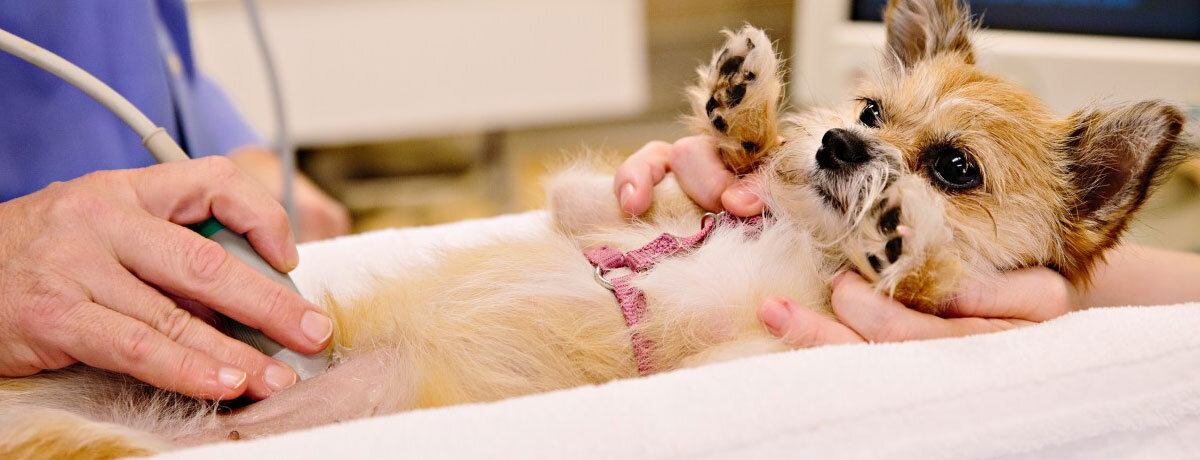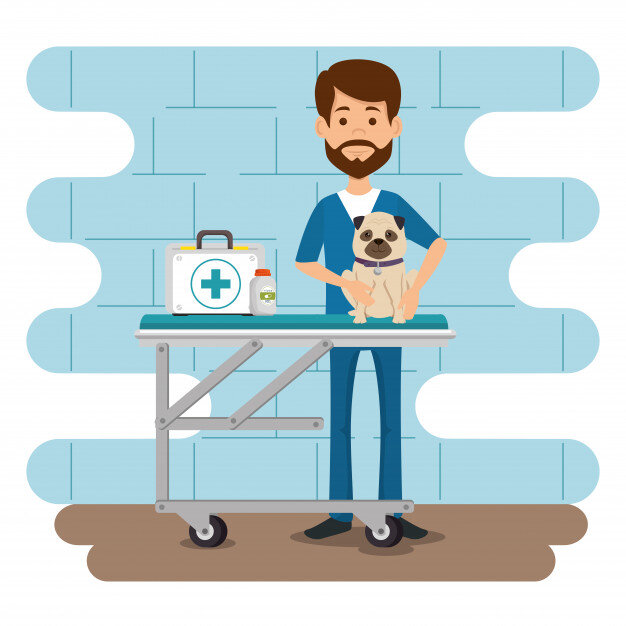
Guide to Veterinary Ultrasound
For Central Texas pets
What is veterinary ultrasound?
Why do we need a veterinary ultrasound?
Where can I get an ultrasound for my pet?
How much does a veterinary ultrasound cost?
Why is it so expensive to get an ultrasound?
Is anesthesia required for veterinary ultrasound?
What are the risks in veterinary ultrasound?
See our answers below!
Ultrasound for animals? Really?
It comes as a surprise for many people that the same advanced diagnostic imaging used in human hospitals is also used in veterinary medicine, right here in Austin and Round, Rock. From MRI machines to CT “cat scanners,” and from ultrasound (sonography) to state-of-the-art PET CT and Nuclear medicine, our furry friends have never had more access to advanced medical technology.
Next to X-ray machines, ultrasound is easily the most widely used diagnostic imaging modality in veterinary medicine, and it’s no surprise. Ultrasound is relatively inexpensive compared to other advanced imaging tools, and many vets are very comfortable using it for everything from puppy checks to finding an intestinal obstruction.
Veterinary ultrasound is widely available throughout central Texas, and exams are available from many different providers, such as small vet offices, specialty centers, and outpatient imaging centers. Costs and quality can vary considerably between these different locations, so make sure to read the overview information below on this page before you make a decision that is right for your particular circumstances. Read on to learn more about what to consider when choosing an ultrasound provider, and what to expect when you get there.
Where can I get an ultrasound for my pet in Austin or Round Rock?
Let’s take a look at a few of the options and how they compare
Vet Offices
THE MOST COMMON PLACE TO GET AN ULTRASOUND FOR YOUR PET IN CENTRAL TEXAS.
Wherever you take your pet for their regular checkup, it’s a good bet that your vet will have an ultrasound machine available to them. In cases where they don’t have an ultrasound machine, or don’t have someone trained to use it, many general practice vets will use a mobile ultrasound service that visits a few times per week for scheduled cases. Learn more about mobile ultrasound services by scrolling down the page.
The Good Stuff
Familiar environment for your pet.
Can be lower cost for ultrasound.
Be Aware
Limited appointment availability for ultrasound.
Ultrasound equipment is usually older and less powerful.
General practice vets may not have formal training in ultrasound.
Many vets are skilled at obtaining good ultrasound images but are not skilled at interpreting those images. They should be sending the images to a radiologist for consultation. Read more about the vital role veterinary radiologists play in veterinary medicine.
Specialty Centers
BOARD-CERTIFIED VETERINARY SPECIALISTS PROVIDE ULTRASOUND AND ADVANCED TREATMENTS TO ANIMALS IN CENTRAL TEXAS.
Otherwise known as emergency hospitals, specialty centers bring together a range of veterinarians with advanced training in particular specialties such as internal medicine, dermatology, surgery, cardiology, and more. It’s a lot like a human hospital, packed into a smaller building. As with your regular vet, these folks are almost certain to have an ultrasound machine in-house.
Examples
The Good Stuff
Specialty centers are a one-stop shop for advanced veterinary medicine.
If your pet needs advanced treatment or complicated surgery after the ultrasound, you’re already there.
Specialty centers almost always send ultrasounds to a radiologist for expert consultation, leading to more accurate diagnosis.
Be Aware
Generally more expensive compared to your regular vet.
Can be a long process to get in and get an ultrasound.
Significant paperwork to set up a new patient file.
Your vet may not want to refer you here because they might lose management of your pet’s care.
Can lead to unexpected costs for other tests.
Outpatient Imaging Centers
WHEN YOU NEED THE LATEST IMAGING TECHNOLOGY, AND A BOARD-CERTIFIED RADIOLOGIST, LOOK NO FURTHER. OUTPATIENT VETERINARY IMAGING GETS ANSWERS FOR CENTRAL TEXAS PETS.
If you have ever needed an MRI or a CT for something routine like shoulder or knee pain, you may have visited an outpatient imaging center. These facilities are common in human medicine, and are just recently gaining popularity in veterinary medicine. Sage Veterinary Imaging is a veterinary outpatient imaging center in Round Rock, Texas, and is currently the only provider of that type in Central Texas.
The Good Stuff
Same-day appointments available
Very little paperwork.
Easy to get in and out.
One-stop shop for imaging and diagnosis. Board-certified radiologists perform the actual ultrasound and consult with you on the results, recommending next steps for treatment.
Usually operates with state-of-the-art imaging equipment as found in human hospitals.
Access to advanced ultrasound-guided biopsy procedures (fine needle aspirates FNA) that are best performed by radiologists.
Often results in lower total cost compared with visiting a specialty center for ultrasound.
Be Aware
Patient needs to be stable— there’s no onsite emergency department.
You’ll need to arrange for treatment somewhere else after getting the ultrasound done. However, SVI’s radiology team will collaborate with your GP and will assist with referrals to specialists.
Mobile Ultrasound
Mobile sonographers provide a vital service to vet offices and specialty centers who sometimes don’t have their own ultrasound machine. Their ultrasound systems are highly portable (think laptop size), which means they can go practically anywhere, including zoos, where they get do do cool stuff like health checks on pregnant tigers!
The Good Stuff
Fills in service gaps for vets and specialty centers.
Less expensive equipment results in lower ultrasound prices.
Usually sends ultrasound images to a board-certified radiologist.
Be Aware
They won’t visit your home. Only vet offices.
May not be operated by a vet or radiologist.
Because the equipment is portable it is also less powerful.
May not be able to perform ultrasound-guided biopsies.
FAQs
What is veterinary ultrasound?
"An ultrasound examination, also known as ultrasonography, is a non-invasive imaging technique that allows internal body structures to be seen by recording echoes or reflections of ultrasonic waves. Unlike x-rays, which are potentially dangerous, ultrasound waves are considered to be safe.
Ultrasound equipment directs a narrow beam of high frequency sound waves into the area of interest. The sound waves may be transmitted through, reflected or absorbed by the tissues that they encounter.
The ultrasound waves that are reflected will return as "echoes" to the probe, and are converted into an image that is displayed on the monitor, giving a 2-dimensional "picture" of the tissues under examination.” -Ernest Ward, DVM
Why does my pet need an ultrasound?
Ultrasound can provide a lot of information for its cost and is often more readily available compared with other advanced imaging modalities such as a CT or MRI.
For example, when a pet has a tumor or ingests something it shouldn’t have, an ultrasound can be helpful to locate these objects and characterize them.
Fluid can be distinguished from soft tissue masses or foreign bodies, which is sometimes difficult to differentiate on X-rays, thus, ultrasound is a useful tool to diagnose patients for hemoabdomen and pericardial effusion, which are blood in the abdomen and around the heart, respectively. Being able to diagnose these conditions can be lifesaving in an emergency situation.
Other indications for ultrasound:
abdominal pain.
pancreatitis.
enlarged abdominal organ.
stones in the kidney or bladder.
portosystemic shunts.
needle biopsies in which needles are used to extract a sample of cells from organs for laboratory testing.
Where can my pet get an ultrasound in Austin or Round Rock?
Ultrasound is widely available throughout central Texas. Exams are available from many different providers, such as small vet offices, specialty centers, and outpatient imaging centers. Costs and quality can vary considerably between these different locations, so make sure to read the overview information at the top of this page before you make a decision that is right for your particular circumstances.
How much does a veterinary ultrasound cost in Austin or Round Rock?
Ultrasound prices vary widely, depending on the location you visit, the age and quality of the equipment, and the skill of the operator. Generally speaking, a standard ultrasound (not including biopsies) will range from $300-$500. For example, a general practice vet in a rural area with an old ultrasound machine might charge $300, while a board-certified radiologist using the latest technology might charge $500-$700.
Why is veterinary ultrasound so expensive in Austin and Round Rock?
Again, ultrasound prices vary widely, depending on the location you visit, the age and quality of the equipment, and the skill of the operator. Although the initial cost of a scan may seem high, it has to be equated with the high cost of the equipment, the fact that specialized training is required in order to interpret the images, and a significant amount of time is involved in carrying out the examination. Its usefulness for pregnancy diagnosis, evaluation of the internal organs, assessment of heart function, and evaluation of certain eye diseases, make it an invaluable, non-invasive diagnostic tool to help protect to your pet's well-being.
Is anesthesia required for veterinary ultrasound?
Anesthesia is not usually needed for most ultrasound examinations, unless biopsies are to be taken. The technique is totally painless and most dogs will lie comfortably while the scan is being performed. Occasionally, if the dog is very nervous, or uncooperative, a sedative may be necessary. Propofol is commonly used in veterinary medicine as a sedative and it is considered generally safe.
What are the risks in veterinary ultrasound?
Unlike x-rays, which are potentially dangerous, ultrasound waves are considered to be safe. If you pet requires anesthesia or sedation, or needs a biopsy, there are some risks involved, but those will be explained in detail to you by your veterinarian.









